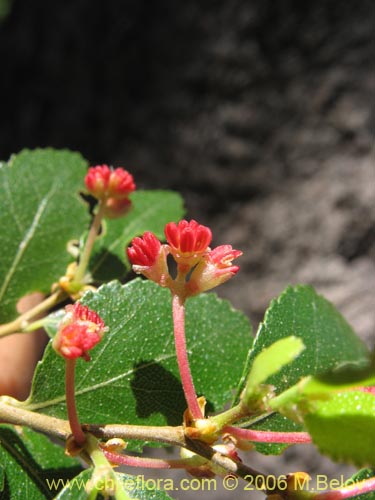Nothofagus dombeyi
Coihue southern beech ( Nothofagus dombeyi )
The coihue southern beech, Coihue or Chilean bill beech ( Nothofagus dombeyi ) is a plant of the genus Nothofagus ( Nothofagus ) in the family of note Fagaceae ( Nothofagaceae ). As the German name, however, were assigned more than once within the genus, the concomitant use of the botanical name is recommended. In Chile, the trivial name Coihue, Coigüe or Coygüe be used.
- 6.1 Notes and references
Description
Appearance, bark and leaf
Nothofagus dombeyi grows achieved as evergreen tree, the growth heights of up to 40, rarely up to 45 meters and trunk diameter of 2.5 to 3 meters. The cracked bark is gray. The young branches are relatively thin and have a reddish-brown bark.
The alternate and distichous to spiral sprig arranged leaves have a 3-9 mm long petiole. The simple, slightly leathery, hairless except for the median nerve leaf blade with a length of 2-3 cm and a width of 1-1.5 cm elliptical or ovate - lanceolate to lanceolate - rhombic and glandular dotted with a wedge-shaped Spreitenbasis. The leaf margin is equal to twice perforated. Stipules are present.
Inflorescence and flower
Nothofagus dombeyi is monoecious getrenntgeschlechtig ( monoecious ). Few small, unisexual flowers are borne in axillary inflorescences. Up to three male flowers are borne in inflorescences and are surrounded by bracts. The 2:2-3 mm long male flowers have four to five scale-like, intergrown bloom and eight to fifteen fertile stamens with reddish anthers. In the female inflorescences are up to three female flowers, which are surrounded by four bracts. Pollination is about the wind ( anemophily ).
Fruit
Three with a length of 2-3 mm small, yellowish to pale chestnut -colored nuts to stand together and be of a fruit cup ( cupula ) surrounded.
Ecology
The coihue southern beech lives in symbiosis with the ectomycorrhizal fungus Stephan Opus stropharioides.
Distribution and threat
The home of coihue southern beech in Chile lies in the regions VI to XI in the provinces of Aysen, Biobío, La Araucania, Los Lagos, Maule and O'Higgins, in Argentina, in the provinces of Chubut, Neuquen and Rio Negro. It thrives in the sub-Antarctic forest mostly at altitudes 700-1200 m and in Patagonia and Tierra del Fuego, they can already be seen at sea level.
The IUCN Red List is classified as Least Concern Nothofagus dombeyi ( " not at risk ").
System
The first description of this kind took place in 1827 under the name Fagus dombeyi by Charles François de Brisseau Mirbel in Mémoires du Muséum d' Histoire Naturelle, 14, pp. 467 1851, Karl Ludwig von Blume in Museum Botanicum, 1, p 307, the genus Nothofagus on and sometimes this publication is also used for a homonym Nothofagus dombeyi ( Mirb. ) flower, but there is this type not mentioned. The valid first publication of the name Nothofagus dombeyi applies only publication in 1871 by Anders Sandoe Oersted in Royal Danish Videnskabernes Selskabs Skrifter - Naturvidenskabelig above Mathematisk afdeling Ser. V, IX, p 354 Nothofagus dombeyi belongs to the subgenus Nothofagus from the genus Nothofagus.
Use
The wood of the coihue southern beech does not rot and is therefore preferred used for relining of roads and trails in the wet grounds, railway sleepers or as a timber.
To Europe Nothofagus dombeyi first attained in 1916. In Central Europe it is not hardy. The coihue southern beech is used in mild climates as an ornamental plant in the British Isles they can reach heights of growth of up to 26 meters.
Swell
- Roberto Rodríguez, Max Quezada: Fagaceae, In: Clodomiro Marticorena, Roberto Rodríguez (Editor): Flora de Chile, Volume 2 ( 2), Universidad de Concepción, 2003 Nothofagus dombeyi on page 69.
- Nothofagus dombeyi in the Enciclopedia de la Flora Chilena - Online.


.jpg/220px-Nothofagus_dombeyi_leaves_001_(Valerio_Pillar).jpg)






